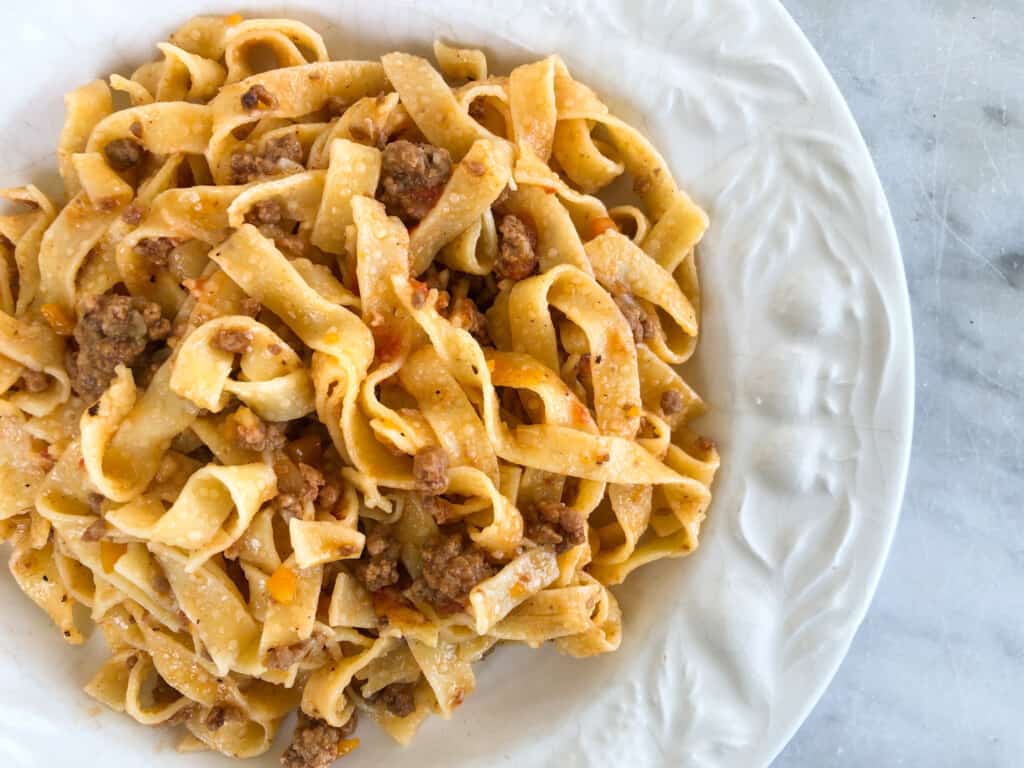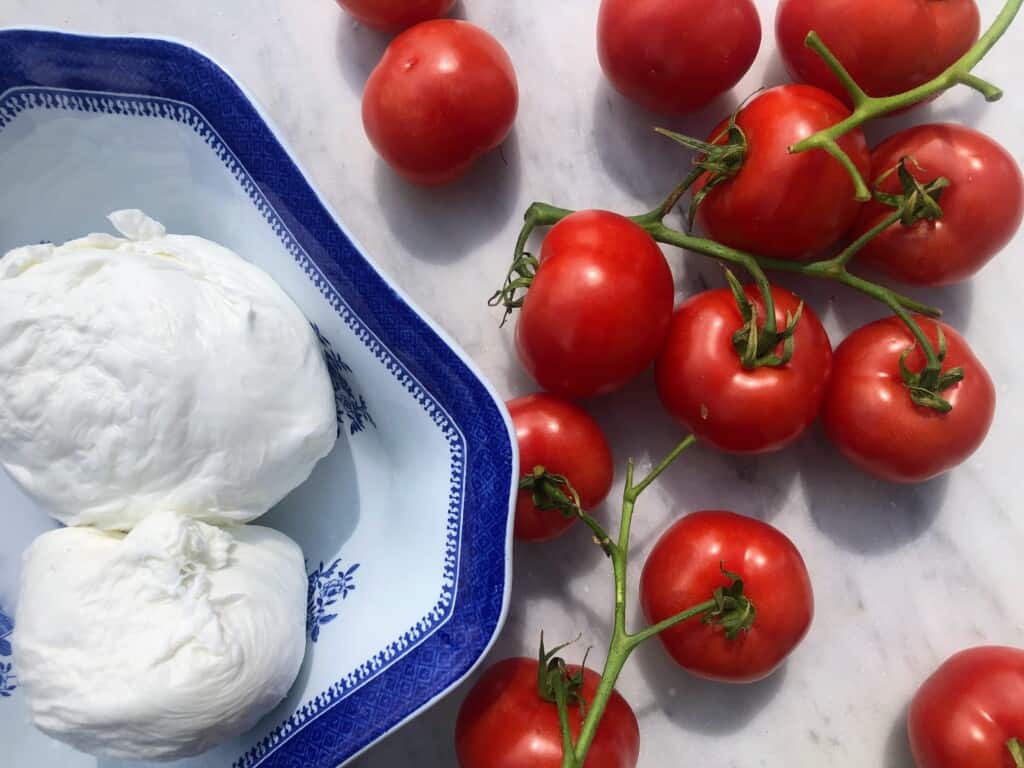Last updated on April 19th, 2024
If you have ever opened an Italian cookbook, visited Italy or simply Googled ‘Italian pasta sauces,; you will most likely have noticed how many there are – hundreds – and each one probably has more than one spin-off and variation. So, which ones are authentic and which ones are not? How might you even start to comb through them all?
Let us help! In this article we are going to go over the most popular, beloved and used sauces in Italy, by actual Italians. We will talk a bit about each sauce, what it’s made from, what to serve it with, and when best to make and eat it.
So the next time you want to make an authentic pasta dish for a crowd, stun your Italian mother-in-law with your expertise pasta knowledge, or make sure you’re eating well while in Italy, take another look at these 30 Most Popular Italian Pasta Sauces, coming to you directly from the source: Italy!
Eat Like An Italian: Learn to eat pasta like a true Italian with our in-depth guide Is it Illegal to Break Pasta in Italy? + Quick Guide to Italian Pasta Etiquette.

Jump to Section
Most Popular Italian Pasta Sauces
| Name | Origin | Main Ingredients | When to eat it | Serve with |
| Puttanesca | Campagnia | tomato, anchovies, olives | year-round | spaghetti |
| Ragù al Cinghiale | Tuscany | wild boar, tomato | winter | pappardelle |
| Ragù alla Bolognese | Emilia-Romagna | ground beef and pork, tomato | year-round | tagliatelle, fettuccine |
| Ragù alla Napoletano | Naples | beef, tomato, wine | fall/winter | maccheroni, ziti |
| Muddica Atturrata | Sicily | breadcrumbs, garlic | year-round | spaghetti |
| Salsa al Limone | Amalfi Coast/Sarento | lemons | year-round | linguine, rotini, tagliolini, tagliatelle |
| All’Arrabbiata | Rome | tomato, chili peppers | year-round | penne, caserecce |
| Pomarola | Italy | tomatoes | year-round | Any |
| Carbonara | Rome | egg, bacon, parmesan | year-round | spaghetti |
| Con Cime di Rape | Italy | turnip greens, garlic | winter | sedani rigati, fusilli, orecchiette |
| Amatriciana | Amatrice | tomato, bacon | year-round | spaghetti |
| Ai Fagioli | Italy | dried beans such as barlotti or chickpeas | year-round | maltagliati |
| Ai Funghi | Italy | wild mushrooms | fall/winter | tagliatelle |
| Boscaiola | Tuscany/Emilia-Romagna | mushrooms, cream | fall/winter | fettuccine, penne |
| Sugo di Noci | Liguria | walnuts, breadcrumbs, parmesan | year-round | ravioli, pansoti, spaghetti |
| Salsa alle Vongole | Southern Italy | garlic, olive oil, clams | summer | spaghetti |
| Salsa allo Scoglio | Southern Italy | clams, muscles, squid and shrimp | summer | spaghetti |
| Al Tonno | Italy | canned tuna, canned tomato | year-round | spaghetti, penne |
| Pesto Trapanese | Trapani, Sicily | almonds, tomatoes, parmesan, olive oil | year-round | spaghetti, penne |
| Olio, Aglio e Peperoncino | Italy | olive oil, garlic, chili peppers | year-round | spaghetti |
| Cacio e Pepe | Rome | Pecorino Romano, black pepper | year-round | spaghetti |
| Al Burro | Italy | butter | year-round | short pasta like penne |
| Al Burro e Salvia | Italy | butter, sage | year-round | stuffed pasta like ravioli |
| Checca | Southern Italy | fresh tomatoes, garlic, olive oil | summer | penne, fusilli, mezze maniche |
| Pesto Genovese | Genoa, Liguria | basil, garlic, olive oil | year-round | tagliatelle, spaghetti, trofie, linguine, penne |
| Friggione | Bologna, Emilia-Romagna | onions, tomatoes | year-round | tagliatelle |
| Alle Zucchine | Italy | zucchini, garlic | summer | short pasta like penne |
| Al Tartufo | Piedmonte | truffles, butter | fall/winter | tagliolini, tajarin, fettuccine |
| Alla Norma | Sicily | tomato, eggplant | summer | rigatoni, ziti, penne |
| Besciamella | Italy | butter, milk, flour | year-round | baked pastas |
Also check out our Favorite Italian Pasta Brands and make sure you know How to Cook Pasta Like an Italian!
Puttanesca
(Pronounced poot-tah-neh-skuh in Italian)
Originating from Naples in Campania, this pasta sauce is made from stewed tomatoes in olive oil with olives, anchovies, chili peppers, capers and garlic.
There are two main theories about the name of this sauce. Legend has it that this sauce was named after the puttane (Italian word for whore) who would leave this sauce simmering so that when she got back from her night out she would have something warm and comforting to look forward to. The name could have also stemmed from the word puttana, a not very nice word Italians use in vain similar to how Americans use the word ‘shit’, meaning the sauce is made from a lot of stuff, or whatever “shit you have lying around”. No one really knows the truth but they are good stories non the less!
Pair with: spaghetti
Ragù al Cinghiale

(Pronounced rah-goo ahl ching-gee-ah-leh in Italian)
Ragù al Cinghiale is a traditional meat ragù originating in Tuscany. It’s made with wild boar meat stewed with tomatoes, red wine, tomatoes, carrots and celery. Although this is particularly popular in central Italy during the winter hunting season, this dish has spread throughout Italy. Typically, this rich ragù is only eaten in the colder months when the cinghiale meat is freshly-butchered.
Pair with: pappardelle
Learn More: Read our comprehensive guide to Traditional Tuscan Foods – A Local’s Tips on Foods You Must Try During Your Visit for even more dishes to try!
Ragù alla Bolognese
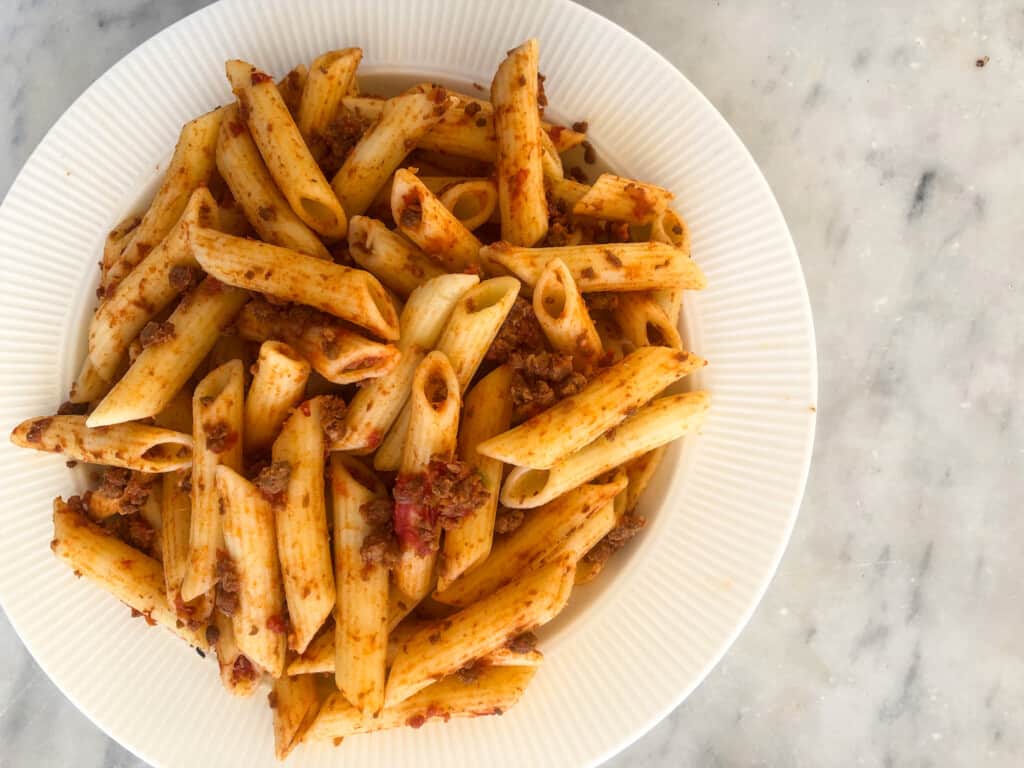
(Pronounced rah-goo ahl-lah boh-lohn-yeh-seh in Italian)
Originally from Bologna in Emilia-Romagna, Ragù Bolognese is made from either ground beef, pork or a combination of both. Onions, pancetta, carrots, celery, salt and pepper are browned with the meat followed by the addition of tomatoes, wine and nutmeg. The sauce is finished with a splash of milk or cream.
Many Italian families will make up huge batches of ragù, freeze it in portioned out containers and dinner is ready in 20 minutes!
Pair with: tagliatelle, fettuccine or used to make lasagna
Learn More: Read our comprehensive guide to Traditional Food of Emilia-Romagna – A Local’s Tips on Foods You Must Try + Restaurant Guide for insider info on local food!
Ragù alla Napoletano
This ragù originating in Naples, Campania is characterized by the chuck meat that is stewed in large pieces with tomatoes and other flavors (instead of ground meat like in traditional meat ragù). To tenderize the meat, it needs to be slow-cooked for a very long time in the tomatoes until it falls apart when pricked with a fork.
This is one of those sauces that’s even better the day after it’s prepared! This is a heavy sauce, as all meat sauces are, so they are best enjoyed in colder months and with hearty pastas.
Pair with: maccheroni or ziti
Muddica Atturrata
(Pronounced mood-dee-cah aht-toor-rah-tah in Italian)
This Sicilian creation is known as the “cheese of the poor,” because it adds lots of flavor to various dishes, including pastas without the high cost of cheese like Parmigiano-Reggiano. Essentially it is made by toasting bread crumbs about the size of grated cheese until golden brown. When they are mixed with fried garlic, anchovies and oil, they make the perfect sauce for pasta when you have nothing in the house.
Pair with: spaghetti
Salsa al Limone
(Pronouced sahl-sah ahl lee-moh-neh in Italian)
Salsa al Limone is a lemon sauce comes from Campania, specifically the Amalfi coast and Sorrento, where lemons grow in abundance.
This is a 5-minute sauce, meaning you can make it while the pasta cooks and you have dinner ready in 15 minutes. Some recipes call for cream, others for butter, but either way a creamy, silky sauce is made from both the lemon juice and zest, enriched with parmesan cheese and thinned out with starchy pasta water. Italians eat this dish both in the winter when the lemons are newly-ripe and also in the summer as a light and easy meal.
Pair with: linguine, tagliolini, tagliatelle or rotini
Learn More: Read our comprehensive guide to Traditional Food of Campania – Foods You Won’t Want To Miss While Visiting for more info!
All’Arrabbiata
(ahl-ahr-rahb-bee-ah-tah in Italian)
Meaning “angry,” this fiery Roman pasta is made hot from plenty of chili peppers that are cooked with tomatoes, garlic and olive oil.
This pasta sauce is enjoyed throughout Italy because of its simplicity. It should be served with short pasta.
Pair with: penne, caserecce
Pomarola

(Pronounced poh-mah-roh-lah in Italian)
Also known as salsa di pomodoro or sugo di pomodoro, this is your classic tomato sauce for which Italians are known.
Although every family will have their recipe and method of preparation, the ingredients are always fresh and of the best quality.
Homemade tomato sauce is made with fresh tomatoes during the summer but during the off season, canned tomatoes are used. I have learned to love and appreciate both for different reasons but I have to say there is nothing better than a tomato sauce made from fresh summer tomatoes and canned for winter months when the sight of a fresh tomato is far out of sight.
This is one of those comfort dishes for Italians as it is a childhood favorite for most. In fact, when adults visit their mothers in Italy, often are sent home with some homemade canned tomato sauce and there is nothing quite like mamma’s!
Pair with: any kind of dried pasta, long or short
Make It: Try the recipe for my family’s pomodoro sauce!
Helpful Tip: Don’t waste that delicious sauce! Learn how and when to fare la scarpetta!
Carbonara

(Pronounced cahr-boh-nahr-ah in Italian)
Carbonara is a classic Roman pasta sauce made with guanciale (similar to bacon), egg yolks, parmesan cheese and freshly cracked black pepper.
While the pasta is cooking, guanciale is fried up and then the cooked pasta is added to the sautée pan with beaten egg yolks, plenty of grated parmesan cheese and black pepper and gently cooked over very low heat until a velvety, creamy sauce forms. Eat quickly though because there is nothing worse than cold carbonara sauce.
This is on a weekly rotation at our house as everyone loves it, including the pickiest eater.
Pair with: spaghetti
Learn More: Read our comprehensive guide to Traditional Food of Lazio – 55+ Foods to Know About Before Your Visit to learn more about Roman pasta!
Con Cime di Rape
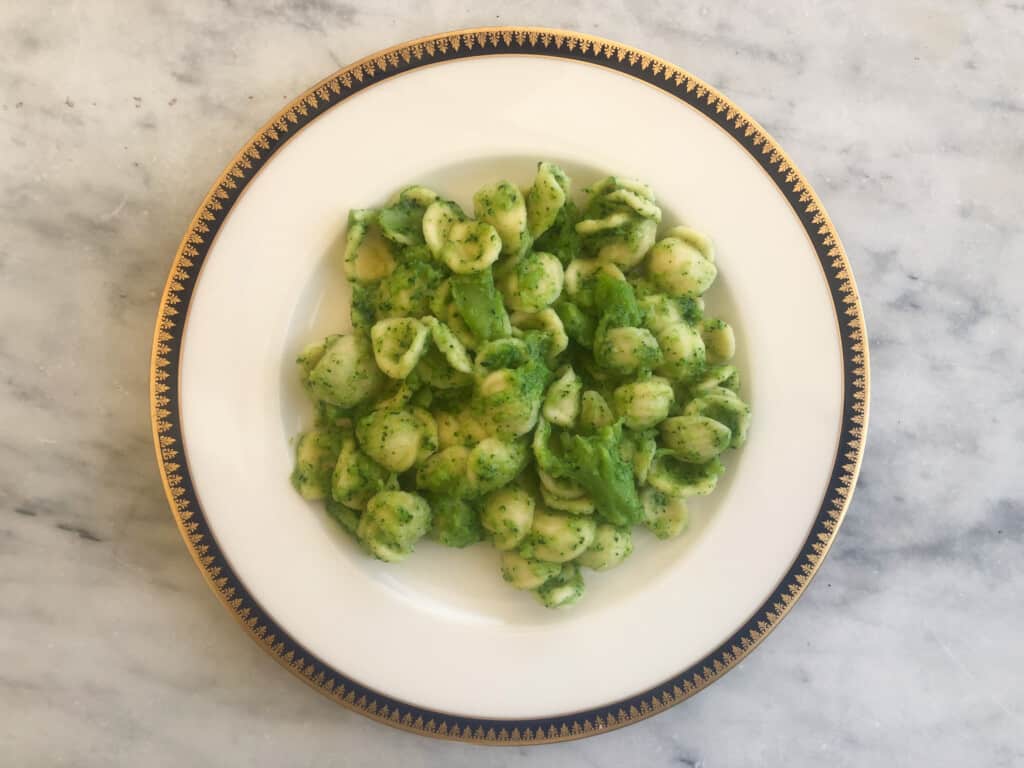
(Pronounced cohn chee-meh dee rah-peh in Italian)
Puglia’s most iconic pasta made from orecchiette pasta served in a sauce made from bitter turnip greens, local olive oil and garlic. This is one of my favorites to make at home with rape from my garden. It’s also vegan! It can also be made with broccoli, which is very similar and also commonly eaten in Rome.
Pair with: sedani rigati, fusilli or orecchiette
Learn More: Read our comprehensive guide to Traditional Food of Puglia – A Local’s Tips on Foods You Must Try During Your Visit for all the insider info on handmade pasta and other favorites!
Amatriciana

(Pronounced ah-mah-tree-chah-nah in Italian)
This simple and satisfying tomato sauce from Amatrice is flavored with guanciale (similar to bacon), olive oil, a pinch of chili pepper, white wine and finished with Pecorino Romano cheese from Lazio. Rich and hearty, amatriciana is another Southern classic which has made its way into the homes of all Italians, no matter where they reside.
Pair with: spaghetti
Ai Fagioli

(Pronounced ahy fah-joh-lee in Italian)
A classic way to prepare pasta throughout Italy is with a sauce made from cooked beans.
Every region has their recipe, some made with chickpeas, others barlotti but the concept is the same. The pre-cooked beans are cooked with a combination of but not always including garlic, anchovies, various herbs, red pepper flakes and local greens. Most often, a portion of the beans are puréed with some of their cooking liquid, creating a creamy base to which the rest of the beans and pasta are added.
This thick soup-like sauce makes for a cheap, hearty and healthy meal.
Pair with: fresh or dried egg pasta that has been cut or broken into smaller pieces such as maltagliati
Ai Funghi

(Pronounced ahy foon-ghee in Italian)
Since mushrooms grow so well in Italy, it’s only logical that Italians live for the moment every year when they can make this hearty mushroom sauce to serve with pasta. Like many Italian recipes, each region has their variation, but generally the mushrooms are cooked with wine and herbs. Some Italians add butter, cream or parmesan, adding a rich creaminess to the sauce.
Fall is the best time to enjoy this pasta sauce because mushrooms start to grow well when it starts to rain and the ground begins to get moist and damp, ideal growing conditions.
Pair with: tagliatelle (try making your own!)
Learn More: Read our comprehensive guide to Umbria Food Guide – A Local’s Recommendations & Tips for more dishes including mushrooms.
Boscaiola
(Pronounced boh-sky-oh-lah in Italian)
Meaning “woodcutter”, referring to the hearty, earthy ingredients that are foraged in the woods to make this pasta. Both fresh and re-concentrated dried mushrooms are cooked with bacon, tomatoes and a splash of cream and quickly cooked over low heat with pasta until thickened.
Pair with: fettuccine or penne
Sugo di Noci
(Pronounced soo-goh dee noh-chee in Italian)
This is a popular dish from Liguria. It’s similar to pesto but made creamy with walnuts, garlic, bread crumbs, milk and Parmigiano-Reggiano.
This ivory white sauce is perfect anytime of the year and a breeze to whip up. You can either make it at home or buy it already prepared in supermarkets.
Pair with: ravioli, pansoti or spaghetti
Salsa alle Vongole

(Pronounced sahl-sah ahl-leh von-goh-leh in Italian)
This is a classic southern Italian dish from Campania but you will find it at any seaside restaurant in Italy. The sauce is simple, made from just garlic, oil, chili peppers, parsley, clams and white wine.
The trick to making this well is to use really good ingredients as they are so few.
This is a summer favorite among Italians when they are on vacation at the beach but it doesn’t stop them from eating it year-round!
Pair with: spaghetti
Salsa allo Scoglio

(Pronounced sahl-sah ahl-loh skohl-yo in Italian)
Salsa allo Scoglio from Campania is a mixed seafood sauce found along the coast of Italy made from whatever is fresh that day but most typically including clams, mussels, shrimp and squid. Some recipes are ‘in bianco”, meaning without tomatoes while others are made with fresh cherry tomatoes.
Either way, this is a favorite among all Italians, adults and children alike as it’s very fun (and messy!) to eat.
Pair with: spaghetti
Al Tonno
(Pronounced ahl-tohn-noh in Italian)
This is one of those pastas Italians make when they have nothing in the house. Canned tuna is cooked with canned tomatoes, garlic and olive oil.
Easy and simple, you won’t meet an Italian who doesn’t know how to make this easy weeknight meal.
And remember, Italians don’t eat cheese with their seafood so don’t be caught dead asking for cheese on this pasta sauce (or any other including seafood!).
Pair with: penne or spaghetti
Pesto Trapanese
(Pronounced peh-stoh trah-pah-neh-seh in Italian)
This is Sicily’s version of the classic green pesto that we all know and love made with tomatoes, almonds, parmesan, garlic, olive oil and some basil.
Originating in Trapani, this reddish-orange pesto is loved throughout Italy and eaten during all seasons but it’s particularly good in the summer months when the tomatoes are vine ripe and the basil is sweet.
Pair with: spaghetti or penne
Learn More: Read our comprehensive guide to Traditional Sicilian Food – Authentic Dishes & the Top 10 Street Foods You Must Try for in-depth descriptions.
Olio, Aglio e Peperoncino
(Pronounced ohl-yee-oh ahl-yee-oh eh pehp-pehr-ohn-chee-noh in Italian)
A great dish to make when you don’t know what you feel like and you don’t really feel like cooking. Garlic and chili peppers are lightly fried in olive oil while pasta is cooking and when the pasta is done, dinner is ready!
Pair with: spaghetti
Cacio e Pepe

(Pronounced cah-choh eh peh-peh in Italian)
This is a very popular Roman pasta sauce that is an Italian favorite, eaten throughout the country. The ingredients are simple but the technique takes a bit of practice to master. Pecorino Romano cheese is made into a creamy sauce with the addition of pasta water and plenty of freshly-cracked black pepper.
Pair with: spaghetti or mezze maniche
Al Burro
(Pronounced ahl boor-roh in Italian)
You know how when you have tummy troubles and you eat simple things like toast with butter? Well, in Italy they eat pasta al burro which is any kind of pasta mixed with melted butter and parmesan cheese. Some people like to add a sprinkling of freshly-grated nutmeg to give it a hint of sweetness.
This is also one of those comfort foods for Italian children. When rice or pasta is served with butter, it’s also known as in bianco, or “in white”, referring to the plain, white color of the meal.
Pair with: short dried pasta such as penne or maccheroni
Burro e Salvia
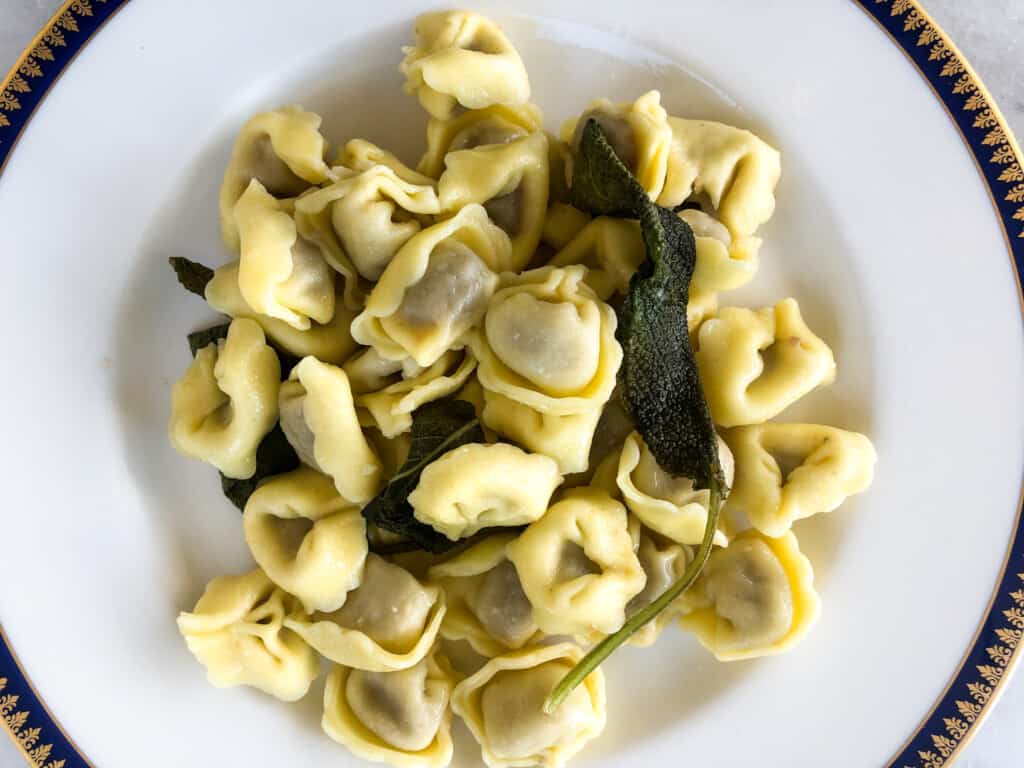
(Pronounced boor-roh eh sahl-vee-ah in Italian)
This is one of the simplest pasta sauces you can make from enriching melted butter with fresh sage leaves. It’s made by melting plenty of butter over medium heat with torn sage leaves (tearing them releases their aroma) until the butter is just browned.
Pair with: stuffed pasta such as ravioli.
Checca
(Pronounced kehk-kah in Italian)
This is one of my favorite recipes to make during the summer months because it’s a no-cook sauce made from fresh tomatoes, parmesan cheese, basil and olive oil. You can either blend everything together in a food processor or simply finely chop the tomatoes and let them marinade in the other ingredients for about 30 minutes before dressing the pasta.
Pair with: short dried pasta such as penne, fusilli or mezze maniche
Pesto Genovese

(Pronounced peh-stoh geh-noh-veh-seh in Italian)
This popular pasta sauce from Genoa in Liguria is made from pine nuts, olive oil, parmesan, garlic and lots of basil. The ingredients are processed together into a smooth, bright green sauce and served over all sorts of pasta.
Many Italians make this at home during the summer when fresh basil is at its best but for the rest of the year they buy very good varieties in the supermarket.
Pair with: fresh egg pasta such as tagliatelle, trofie or any kind of dried pasta including spaghetti, linguine, penne and fusilli
Tip: Learn How to Freeze Fresh Basil so you can have it at your fingertips year round!
Friggione
(Pronounced freej-joh-neh in Italian)
This is a rustic yet satisfying sauce made from lots and lots of onions that are slow-cooked in tomatoes. Originally, this sauce is made from Medicina onions which grow just outside of Bologna in Emilia-Romagna, from where this sauce originated.
This sauce can be used to make crostini, can be served with meat but also, it’s great with pasta.
Pair with: tagliatelle or other egg pasta
Alle Zucchine

(Pronounced ahl-leh zook-kee-neh in Italian)
Summer zucchini are the star of this sauce made from zucchini, olive oil and garlic.
Like many other vegetable-based pasta sauces, this one differs from region to region and family to family. At our house, we make it with paper-thin sliced zucchini that are slowly cooked for about an hour with garlic and lots of olive oil.
Other Italians enjoy a bit of prosciutto crudo or chili pepper or like to puree the sauce.
Either way, it should be served with lots of Parmigiano-Reggiano.
Pair with: any short pasta such as penne, fusilli or rigatoni
Al Tartufo

Truffles have been used in Italian cooking for centuries as they grow so well in the dense forests throughout most of the country and particularily prized in Piedmont. Whether you use black or white (much more prized and expensive than the black variety), this sauce is rich and earthy, made with shaved truffles and butter.
Many Italians like to add parmesan cheese but others think it is sacrilegious.
Pair with: tagliolini, tajarin or fettuccine
Learn More: Read our comprehensive guide to Traditional Food of Piedmont– A Local’s Tips on Foods You Must Try During Your Visit for even more dishes to try!
Alla Norma

(ahl-lah nohr-mah in Italian)
Definitely the most popular pasta sauce in Sicily and loved in many homes throughout Italy as well. The sauce is made with a base of tomato and fried eggplant, topped with a grating of ricotta salata and chopped basil.
Pasta alla norma can be made so many different ways: the eggplant can be fried and then stewed in small pieces with the tomato, it can be sliced and served on top of the tomato sauce or it can even be prepared into a smooth, silky sauce that has been stewed so long that the eggplant and tomatoes have melted into one another.
This is a great vegetarian option that I always keep in mind when we have guests who don’t eat meat and I want to make something hearty.
Pair with: rigatoni, ziti, penne
Besciamella

Although you will never see pasta served with just besciamella, it’s very important for many of Italy’s most beloved baked pastas. This rich and creamy sauce, originally from France, is made from flour, milk and butter, flavored with salt, pepper and a hint of freshly grated nutmeg. It’s very easy to make and used throughout the country not only in pastas but also in secondi.
Pair with: baked pastas such as lasagne
Learn a Trick: Read The Secret Ingredient That Takes Any Pasta Sauce to the Next Level.
